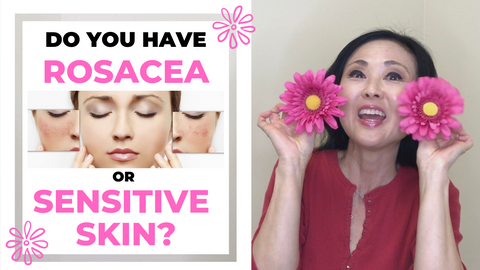How to get rid of dry vs dehydrated skin? What’s the difference and how do you treat each one?
As we get into the colder months of winter, most people will experience dry skin….or is it dehydrated skin?
The oscillating temperature of the cold air and the heat inside can wreak havoc on your skin.
Dry vs dehydrated skin is one of the most misunderstood and misdiagnosed skin conditions.
Click on thumbnail to play:
How the Skin Functions:
First, the very top layer of your skin (otherwise known as the Stratum Corneum) plays a key role in the function, health, and maintenance of your skin.
So, think of your Stratum Corneum as a brick wall. Just like this one:

The Bricks represent the dead skin cells called corneocytes. The dead skin cells contain a complex integration of
Salts, Amino Acids, Urea, and Lactic Acids. This is referred to the NMF or Natural Moisturizing Factor. The cement that is in between the bricks and holds the bricks together, are made up of ceramides, cholesterol, and fatty acids.
Essentially, they organize themselves into layers which creates a natural water binding material for the skin.
When there is a break down in the bricks or the “cement”that holds the bricks together, the skin loses its ability to hold onto the moisture. Ceramides are natural lipids that hold the skin cells together. They are vital for moisturized skin.
Your skin will become dry, irritated, and sensitive without them.
When the overall balance of the skin thrown off, you can experience TEWL or Trans Epidermal Water Loss. This can lead to inflammation, and with additional UV exposure, a collapse of the extracellular matrix.
Without enough moisture, the natural desquamation process or shedding of dead skin cells in interrupted. The build up of dead skin cells will result in dry, flaky, wrinkling, laxity and overall a more aged appearance.
When you have an excess build up of dead cells on the surface, this not only traps dirt and debris, it also decreases the absorption of any anti aging or any other topical ingredients applied on the skin.
Misunderstood facts about Dry vs Dehydrated skin:
MYTH #1:
“My skin is dry because I don’t drink enough water.”
Drinking water helps the skin by helping the other major organs function. Water will be directed to the excretory system before it even reaches the superficial layer of the skin. For example, if you drank a liter of water, 20-30 minutes later, you would have to use the restroom before it even hydrated your skin.
Dehydration is the lack of water in the skin and a stripped acid mantle. The cause of dehydration is more related to the extrinsic factors such as not using products correctly, lack of products , and/ environmental causes.
Signs of Dehydrated skin:
The appearance of dehydrated skin are crinkly, and flaky but shiny. It will have a cellophane look to the skin. This is especially obvious when the client is oily and dehydrated because the oil is trapped under the flaky dead skin. This look is also common with people over using Retin A or Retinoids.
MYTH#2: “I need a heavy cream because my skin is dry.”
Dehydrated skin needs moisture containing water NOT oil.
When you apply heavy creams created for dry skin on top of dehydrated skin, the heavy cream will only sit on top of a layer of dead skin. This will not add any moisture to the skin and can leave the skin feeling greasy.
If you’ve ever applied lotion to your hands or legs and felt like your skin was still dry or looked dry, it’s more than likely that the lotion contained little to no humectants, which adds moisture to the skin. The lotion probably contained more occlusives such as oils or petroleum based products.
This is why people who have oily skin or break out prone skin avoid moisturizers because they think the cream/moisturizer will cause break outs.
When in fact, using acne clearing products may initially clear up the break outs, but continually using acne clearing products without adding moisture, will strip the acid mantle. Extreme dehydration can cause more break outs because the dehydrated skin can over produce oil to slow down superficial moisture loss.
Oil can cause break outs and water binding serums help increase moisture resulting in less oil production.
MYTH#3: Dry skin Ages Faster
Actually, dehydrated skin can cause more damage to the skin than dry skin every will.
Many people who think they have “sensitive” skin , actually may be experiencing the sensitizing effects of dehydrated skin.
Sensitization is one of the worst results of dehydrated skin because the inflammation signals the metalloproteinases or MMP’s to break down the existing collagen in the skin which prematurely ages the skin.
Dehydrated Skin Needs Humectants and Dry Skin Needs Occlusives
Humectants attract water and pull it into the epidermis from the dermis such as:
–Glycerin/Urea-provides surface hydration and infusing moisture into the skin cells directly.
–Hyaluronic Acid-a humectant that brings moisture to the skin and binds to water up 1000x its weight in water.
–Sodium PCA-attract and hold 250x its weight in water.
-Aloe Vera Juice-Absorbed into the skin. Neutral to pH to be easily replaced with water for formulation with more hydrating properties han water . Also contains trace minerals to help reduce inflammation in the skin.
BEST MOISTURE BOOSTER FOR BOTH OILY AND DRY SKIN
What Dry AND DEHYDRATED skin needs: Occlusives
Occlusives lock in moisture that the humectants attract into the skin. If there are NOT occlusives, than the moisturizer can actually make the skin even MORE dehydrated because all the moisture will evaporate from the surface of the skin.
Products that contain occlusives are best utilized after a shower when your skin is moist and the pores are open.
***NOTE- Occlusive agents do not necessarily provide added benefits to the skin, they help keep moisture in by just staying on top of the skin.
Some occlusive agents that are NOT recommended for acne prone skin:
-Petroleum (also listed as petrolatum)
-Mineral Oil
-Lanolin
Light Occlusives actually HELP spread the moisture around the skin such as a water dispersible oil:
-Grapeseed oil
***PRO TIP: Hyaluronic Acid not only is a humectant but also has the benefits of an occlusive agent due to its larger molecular size.
It sits on the skins surface to pull moisture into the epidermis and reduces and prevents TEWL.
Finally, to get the benefits of adding hydration and moisture onto the skin, here are the tips to help increase hydration:
-Exfoliate regularly (Which Exfoliation is best for my skin type)
-Apply a hydrating serum
-Use a spray toner liberally (WITHOUT ALCOHOL-Adds moisture on the skin for the humectants to attach onto)
-apply moisturizer while face is still wet with the toner
For a more detailed step by step instruction on how to apply your skin care products correctly for maximum benefit,
please go to the blog post.
YouTube Channel: https://www.youtube.com/channel/UC4XGWX6eheTisHo8UBsdOWA
Instagram: @GoSeeChristy
Facebook: https://www.facebook.com/goseeChristyBeautyBoutique/
Twitter: https://twitter.com/goseechristy
Pinterest: https://www.pinterest.com/goseechristy/



